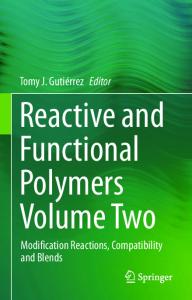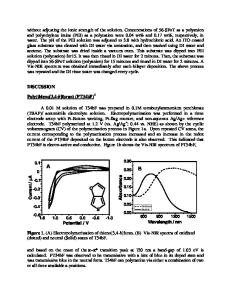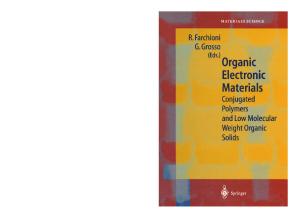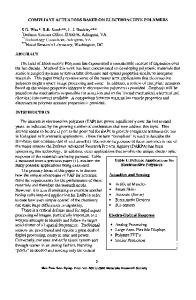From Conducting Polymers to Electroactive Hybrid Materials
- PDF / 255,747 Bytes
- 14 Pages / 612 x 792 pts (letter) Page_size
- 36 Downloads / 338 Views
From Conducting Polymers to Electroactive Hybrid Materials Pedro Gómez-Romero, Monica Lira-Cantú Materials Science Institute of Barcelona (CSIC), Campus UAB, 08193 Bellaterra, Barcelona, Spain. E-mail: [email protected]
ABSTRACT Electron or hole conductivity in conjugated polymers provided their initial thrust, but conductive polymers also display interesting electrochemical properties which constitute the base for their application in different types of electro-ionic devices. A further step in the development of functional materials based on conductive polymers is provided by the design of hybrid materials. In hybrid organic-inorganic materials based on conductive polymers, the electroactivity of molecular doping species or other inorganic components is added to that of the polymers themselves, leading to a whole new spectrum of hybrid materials that allow for the harnessing and control of the electrochemical properties of molecular species and put them to work in the development of all sorts of functional materials and devices, from sensors or catalysts to rechargeable lithium batteries, supercapacitors or photoelectrochemical devices. In this chapter we present several examples of this type of functional materials, their synthesis, properties and applications. We will present a general overview of this field and will discuss in some detail the design of insertion electrodes based on conducting polymers and hybrid organicinorganic materials based on them, analyzing their peculiar ion-inserting mechanisms and their possible application in energy storage devices.
INTRODUCTION 1. Conductive Polymers. From Pigments to the Nobel Prize. The history of conducting polymers is a fascinating sequence of discovery and rediscovery, crowned by the 2000 Nobel Prize in chemistry, but still in evolution. Much remains to be done, especially on aspects related to the application of these unique materials, possessing a peculiar combination of properties that allows to forecast a bright technological future for them. As for many other complex chemicals, the origins of conducting polymers go back many years before their true chemical nature could be established. Polyaniline (PAni) constitutes a typical example. It was the year 1862; the United States were in the middle of a civil war and Charles Darwin's best-seller on "the Origin of Species" had seen the light only three years earlier. That year, H. Letheby, from the College of London Hospital published the synthesis of a product partially conductive by means of the electrochemical oxidation of aniline in sulfuric acid. That is the first reference to what could have been the synthesis of a conducting polymer. But Materials Science had not been invented yet and the remarkable conducting nature of that solid was to remain dormant for more than a century. In the golden age of synthetic pigments, with Sir Q11.5.1 Downloaded from https://www.cambridge.org/core. HKUST Library, on 16 Feb 2018 at 01:46:09, subject to the Cambridge Core terms of use, available at https://www.cambridge.or
Data Loading...











